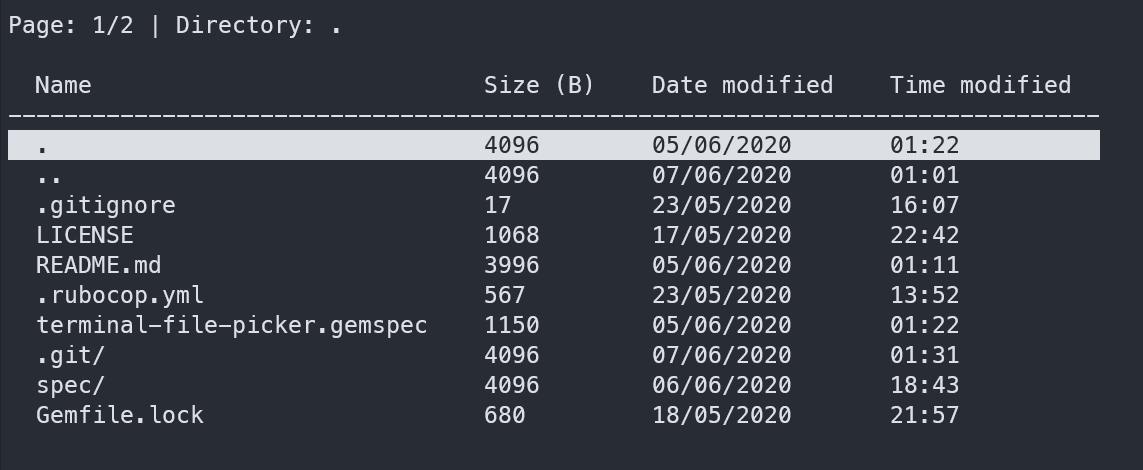Terminal File Picker
This gem shows an interactive terminal file picker to user, allowing them to browse their files with arrow keys and file. The picked file path is then returned to the calling program. The file picker is completely text-based and can be used with a terminal or terminal emulator. It is essentially a terminal version of a GUI file choosing dialogue.
The gem is useful when your program needs to accept a file path as input and you want a more user-friendly option than asking user to find out the file path and enter it as text.
The gem does not rely on the Curses library and instead uses the TTY toolkit, which has cross platform support and support for many types of terminals/terminal emulators. Therefore this gem should also have the same level of support.
Installation
gem install 'terminal-file-picker'or add it to your project's Gemfile:
gem 'terminal-file-picker'Simple Usage
require 'terminal-file-picker'
# Only required argument is the "root path". The user will
# start navigating from the root path once file picker is invoked.
# Root path can be either absolute or relative.
picker = FilePicker.new('.')
# `pick_file` brings up the interactive file picker. Once the user
# has picked a file, the picker is cleared from screen and
# the chosen file path (as an absolute path) is returned.
# If user picks a directory, instead of returning its path,
# the files inside the chosen directory is shown instead.
puts(picker.pick_file)Options
There are some options to customise the look and feel of the file picker (all options do have default values, so all are optional)
The table headers can be changed (e.g. for internationalisation of if you want shorter headers).
FilePicker.new('.', header: ["Nm.", "Sz.", "Date md.", "Time md."])You can change the current directory label which by default says "Directory" in the info line.
FilePicker.new('.', dir_label: 'Dir')You can change current page label which by default says "Page" in the info line.
FilePicker.new('.', page_label: 'Pg')You can change paddings of the table (in terms of number of spaces)
FilePicker.new('.', left_pad: 1, right_pad: 1)The file picker automatically paginates files. You can set how many files there should be in each page (10 by default)
FilePicker.new('.', files_per_page: 20)You can choose to hide the info line (the line which shows the current directory and current page)
FilePicker.new('.', show_info_line: false)You can also change the position of the info line (valid values are :top or :bottom. :top is the default)
FilePicker.new('.', info_line_position: :bottom)You can change the date and time format of date modified and time modified columns. The format can be specified using the same format accepted by the built-in strftime function.
FilePicker.new('.', date_format: '%d-%m-%Y', time_format: '%H.%m')Development
- Officially, this gem supports Ruby versions >= 2.0.0 and such a Ruby version should be used during development as well.
- Tests are written with Rspec, version ~3.9. Run the tests on terminal with
rspecin the project directory (need to install rspec first). -
Rubocop version ~0.8.2 is used to check for use of best practices and standard styling. Run Rubocop on the terminal with
rubocopin the project directory (need to install Rubocop first). Currently, there are a couple of failing Rubocop checks which will be fixed soon.
